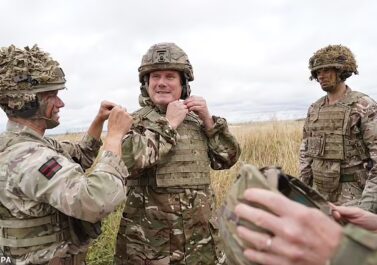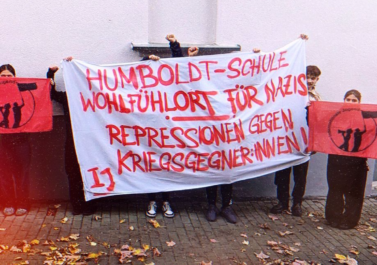
This is the fifth part of our series of translations of articles by Wildcat on the current global moment. The first part shed a critical light on the concept of ‘geopolitics’ and sketched out the current bloc formation. The second part had a closer look at the relation between China and the US within global capitalism. The third part deals with the relation between energy transition and global imperialist tension. The fourth part analyses the current drive for militarisation and the military problems of US hegemony. This part looks at the historic role of large parts of the political left when it comes to supporting capitalist war efforts.
For two and a half years, the West has been fanning the hope that Russia could be completely pushed out of Ukraine. This is completely illusory. The opposite claim, that ‘Putin’, after having invaded Ukraine, would incorporate larger and larger parts of Europe, is also misleading and simply illogical. They tell us that Russia will have no more tanks in two years time, if not earlier. At the same time, the inspector general of the Bundeswehr and Minister Pistorius warn that Russia will be ready to attack NATO in five years and that Germany has only this narrow window of opportunity to become ‘war-ready’. NATO has known for some time that it will not win the war in Ukraine. However, it rules out negotiations and insists on a ‘just peace’. When has there ever been a ‘just peace’ in history? It is just as much a chimera as a ‘just war’. By ‘just peace’, NATO means ‘victorious peace’. But in war, there is rarely a victory; only militarists and warmongers promise that. If the war is ended piecemeal without a ‘victory’, the Ukrainians face a rude awakening. The Vietnamese, Iraqis and Afghans can tell you a thing or two about it. Of the 61 billion USD that the US Congress released ‘for Ukraine’ at the end of April 2024, 7.8 billion USD were for ‘economic support’. 13.7 billion USD for arms deliveries in a triangular transaction: Ukraine receives money from the American taxpayer to buy weapons from American companies. More than half of the total, 37 billion USD, will be used directly to replenish the weapons and ammunition depots in the United States. A 25% haircut on the debt by its largest creditors (Blackrock, Pimco, etc.) and the exchange for new bonds with a rising interest rate averted a national bankruptcy at the last minute. The national debt currently stands at 143 billion USD, 94% of GDP. IMF loans are just enough to cover interest payments and are tied to the usual ‘structural adjustments’: sell-off of agricultural land, privatisation of thousands of state-owned companies, looting of the pension system, cuts in social assistance, cancellation of subsidies for gas and electricity. New tax increases will further exacerbate poverty.
NATO continues to escalate
Nuclear weapons spending has increased by 45% in the US over the past five years, followed by the UK with 43%. In early June, NATO Secretary General Jens Stoltenberg announced an 18% increase in military spending in Europe and Canada, ‘the largest in decades’. In the same month, he stated that NATO was considering putting additional nuclear weapons on standby ‘to be prepared for all eventualities’. And in July, during the celebrations marking NATO’s 75th anniversary, the US announced in four sentences that it would be stationing Tomahawk cruise missiles and supersonic weapons with ranges of up to 2,500 kilometres in southern Germany. These typical first-strike weapons can reach Moscow and other Russian cities in a few minutes. They have a very high degree of accuracy – a so-called ‘decapitation strike’ would be conceivable. Russia declared that it would respond ‘militarily in kind’. The Chinese government also reacted with harsh words; NATO is further fuelling tensions with its ‘belligerent remarks’. The deployment of long-range weapons is not a response to Russia’s invasion of Ukraine in February 2022; it was prepared in spring 2021 and decided in autumn 2021 – without consulting the German government. [1] The EU is also pushing ahead with militarisation. Defence programmes and funds have multiplied to promote cooperation in the research, development, production, acquisition and export of weapons. In 2017, there were two ‘pilot programmes’ for research and development in the defence sector. This was followed in 2020 by the European Defence Fund (EDF), which has a budget of eight billion Euros. The ‘European Peace Facility’ of March 2021 is used for the joint procurement of weapons, subsidising EU defence budgets. It was followed in 2023 by EDIRPA (European defence industry reinforcement through common procurement act), a 300 million Euro fund for the short-term procurement of ammunition. In January 2024, the Defence Equity Facility (DEF) was announced, in February the EVF was increased by 1.5 billion Euros and two new programmes were launched to strengthen the EU defence industry: the European Investment Program for Defence (EDIP) and the European Defence Industrial Strategy (EDIS). In March 2024, the Ammunition Production Support Act (ASAP) was passed. [2]
The mental internal armament
The Westphalian Peace Prize is the highest peace-related award in Germany. The Peace of Westphalia ended the Thirty Years’ War in 1648 and established the principle of non-interference in the ‘internal affairs’ of states. At the end of May, Macron received this 100,000-Euro ‘Peace Prize’ after he had spoken of sending French troops to Ukraine. In mid-July, the Bavarian state government passed a law obliging universities and schools to cooperate with the Bundeswehr. Universities are not allowed to prohibit military use of their research; there is an offer to cooperate with the Bundeswehr, and in matters of national security there is even an obligation for universities to cooperate. Part of the moral rearmament are claims that are currently published everywhere according to which humanity has been waging wars for most of its history. This is a lie! There have been many more phases of peace; war is the exception. The period with the most wars is Europe between 1500 and 2000. Anyone who suspects a connection between capitalism and war is not entirely wrong! And capitalism is also accompanied by the industrialisation of killing. Since the Second World War, the population of the enemy country has increasingly been the target of attacks, while the generals stay far away from the action. ‘If those in power were rational, there would be fewer wars,’ writes Michael Mann in his book ‘The Sources of Power’, [3] which has just been published in German. Most rulers who start wars lose them, and from a historical perspective, the vast majority of states have perished as a result of war. Defence is considered legitimate and rational – although, as Mann shows, submission would often be more ‘rational’. When the war in Ukraine started, the Antifa jumped at the fairy tale of a national liberation struggle – although the defeat of their rulers in war can sometimes be the better solution for the ruled.
The historical failure of the left
In the face of war, the left has always disintegrated: in 1914, the SPD approved war credits; during the Yugoslav wars, leftists called for the NATO bombing; in the war in Ukraine, many called for increased arms deliveries; and in the multi-front war in Palestine since 2023, many have sided with the Israeli government. Yugoslavia, Ukraine and Palestine were and are also civil wars (one part of the population is fighting against another). This is used to justify military intervention from outside – which generally makes the situation worse. In the face of the almost ten-month genocidal war in Gaza, one must speak of an historic failure of the left, especially in Germany, where the mindlessly pro-Israeli position of the ‘Anti-Germans’ continue to play a major role. At the end of July, there were officially almost 40,000 dead in the Gaza Strip; according to a study in the medical journal ‘The Lancet’, as many as eight percent of the population could already be dead. [4] Israel’s government is using its ‘total war’ against Hamas as a pretext for the assassination of civilians, the expulsion of the population from the Gaza Strip and the brutalisation of the apartheid system in the West Bank. It has made no secret of this from day one. ‘I have ordered the complete siege of the Gaza Strip. There will be no electricity, no food, no fuel. Everything will be closed.’ (Israeli Defence Minister Yoav Gallant on the 9th of October) The Minister for Religious and Cultural Heritage suggested dropping a nuclear bomb on Gaza. Bombing of refugee camps in areas previously declared ‘safe’ and the assassination of 108 journalists to date are happening with the approval or even direct complicity of Western governments, especially the US. We have included a slightly abridged version of Marco Revelli’s discussion of Enzo Traverso’s recently published book ‘Gaza davanti alla storia’ in Italy. [5] Revelli attempts to explain both, how we can even start to conceptualise the massacre in Gaza and why it took so long for us to mobilise against it. In his distinction between the actions of the ‘traditional’ liberation movements and those of Hamas, Revelli oversimplifies it. There were many actions of national liberation movements that had the goal of killing civilians. The subsequent indiscriminate retaliation by the opponent was often part of the calculation, as a means to mobilise the population against this retaliation.
Footnotes
[1] A report by the US Congressional Research Service on the timeline states: ‘On 13 April 2021, the Army announced that it would deploy its 2nd MDTF (Multi-Do main-Task Force) in Germany. … On 16 September 2021, the Army activated the 2nd MDTF at Clay Kaserne in Wiesbaden… On 10 July 2024, the White House issued a joint statement with Germany, following talks in advance of the NATO summit. Source: Congressional Research Service: The Army’s Multi-Domain Task Force (MDTF) updated July 10, 2024 https://crsreports.congress.gov/product/pdf/IF/IF11797
[2] This is only a small selection. You can find more details at the Informationsstelle Militarisierung e.V.: Overview of ‘EU militarisation’ https://www.imi-online.de/themen/eu-militarisierung/ and the very latest: https://www.imi-online.de/2024/07/30/eu-aufruestungs- and confrontation programme/
[3] Michael Mann: On Wars; Hamburg 2024; original edition: On Wars, Yale University Press
[4] Khatib/McKee/Yusuf: ‘Counting the dead in Gaza: difficult but essential’. thelancet.com, 5 July 2024.
[5] In mid-April, Traverso published a shorter article in the German edition of Jacobin: ‘Reason of State endangers democratic culture’. Online at www.jacobin.de.



